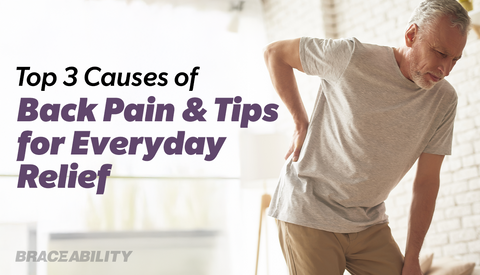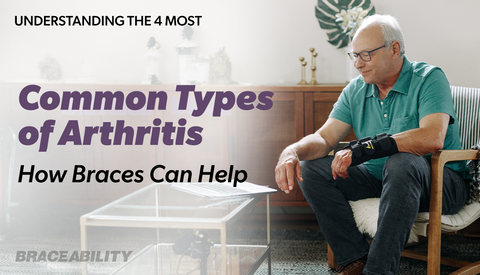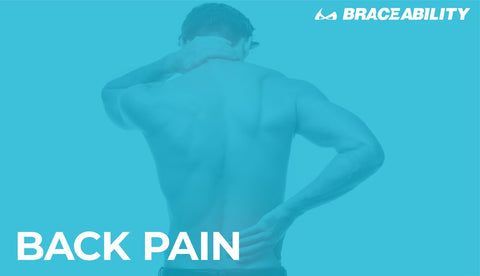Left Side Back Pain
Unfortunately, the truth behind left side pain is that there is not one solution. The structure of your bones and muscles from top to bottom are very different and do not share the same treatments. Because of this, this guide is organized by conditions, symptoms, causes and treatments for pain in your upper left side, lower left side, and left hip or groin. Start by locating the area in which you have pain. Once you have found it, read more on the potential conditions in this region, what is likely causing the pain, and how you can best treat it!

The Top 2 Reasons for Upper Left Back Pain
Upper left side back pain is less common than lower left back pain. This is because the bones in the upper region of our bodies are much less flexible than bones elsewhere. This area is commonly known to range from the base of the neck to the rib cage. This includes the shoulder blade and the connection of the rib cage to the thoracic region. The area includes many structures that may cause pain, including shoulder joints, muscles, tendons, ligaments, and nerves. Common issues in this area arise from the musculoskeletal, this includes conditions such as fractured vertebrates.
-
Pinched Nerve or Cervical Radiculopathy
“My pain is radiating down the left side of my neck”
Symptoms for Pinched Nerves
If you have a pinched or inflamed nerve in your upper left back your symptoms are most likely pain that is sharp and radiating down your neck, numbness or burning sensation, or the feeling of weakness on the upper left back.
Pinched Nerve Causes
The most common reason you are experiencing neck and shoulder pain on the left side is because of a pinched or inflamed nerve that occurs within your spine. Your nerves are the main carriers of information from the brain to the rest of the body, and vice-versa. If a nerve is pinched or inflamed, the signal of this information sending is interrupted in some way. A pinched nerve occurs when too much pressure is applied to a nerve by surrounding tissues. This can be caused by a variety of things, including compression, constriction, or overstretching of the nerve. Pinched nerves can happen as a result of things like a herniated disc, degenerative disc, and bony growths.
Treatments for Pinched Nerve
If you’re suffering from a pinched or inflamed nerve we highly recommend rest for a faster recovery. Along with rest, some use medication, physical therapy, or anti-inflammatory medication to tame the inflamed nerves. It’s also recommended that you isolate your neck and keep it still during your recovery time. Neck collars or immobilizers are a great way to help lead you towards a faster recovery by isolation of the neck.
-
Arthritis / Cervical Spondylosis:
Symptoms of Arthritis
If you have arthritis, you are most likely experiencing stiffness in your neck. You might also have headaches and a grinding or popping sensation when turning your head. In more serious cases, numbness and weakness may occur in your arms, hands and fingers.
Causes of Arthritis
Arthritis is a condition that affects the joints, muscles, and/or bones. Any portion of the back can be affected by arthritis, including the upper left side of your back. However, it is worth noting that the lower back is the most common site for arthritis. Most of the causes associated with upper left back arthritis are age-related. This means that upper back arthritis tends to be a degeneration disorder. This type of neck arthritis is often referred to as cervical spondylosis.
Arthritis Treatment
The key to treating upper left back arthritis is to work on strengthening and improving the flexibility in this area. Stretching and exercising is highly recommended in the recovery of cervical spondylosis.

3 Main Causes of Lower Left Side Back Pain
If you’re experiencing lower left side back pain, you’re not alone! Nearly 60% of adults feel some form of lower back pain in their lifetime. Lower left back pain is more common compared to the back pain felt in the lower right quadrant. Often we define lower left side back pain as ranging in between your hip and leg. Many people describe their lower left pain as dull and achy. Oftentimes the pain in the lower back is known to increase with the intensity of activities. For example, you may feel the most pain when carrying groceries or going for a run. The good news is, it often feels much more serious than it actually is. Most conditions that are associated with lower left back pain are fairly treatable, however, there are a few instances that may be something more serious.
-
Lower Back Muscle Strain
Muscle Strain Symptoms
Strained muscles typically feel tight, dull and/or achy. These feelings intensify with movement that activates the affected muscle such as bending over or standing up from being seated. Some inflammation may come with a low back muscle strain as well. You can be fairly confident that it is a muscle strain if no movement and rest is when you find the most relief.
Causes of Muscle Strains
This injury generally isn’t too serious and often goes away on its own. However, there are circumstances where the injury could be more severe. Muscle strain happens when the muscles in your body are overstretched or torn. In serious cases, muscle stains can result in damage to the muscle fibers. Keep your body active and flexible to avoid causing muscle strain down the road.
Treatments for Muscle Strain
Rest and medication are the best way to get rid of your pain quickly. However, you never want to rest for too long because this will weaken your muscles. Most muscle strains should go away within four days to a week. Another great option is bracing this area of the body. A low back support can be a great way to help prevent future muscle strains as well.
-
Herniated Disc
Symptoms of Herniated Discs
Herniated discs can be tricky in diagnosing because in some cases, there are no noticeable symptoms. Other times, pain, numbness or weakness occur in the lower left region of your back. This pain stems from nerves near the affected disc. The pain most commonly felt is described as numb and progressively worse at night. Herniated discs often worsen when performing an activity such as walking or running.
Causes of Herniated Disc
Your spinal column is made up of a series of vertebrae stacked one on top of the other. These vertebrae range from seven in the cervical spine, 12 in the thoracic spine, and five in the lumbar spine. These vertebrae are cushioned by discs that protect them and absorb shock. It’s not uncommon for one of these discs to slip; this is referred to as a herniated disc. The lower back is one of the most common places to experience a herniated disc.
Herniated Disc Treatments
Treatments for a herniated disc can vary greatly. The treatment you and your doctor decide on will depend on the level and frequency of discomfort. Many people can relieve herniated disc injuries through exercise and physical therapy. We highly recommend you avoid heavy lifting during recovery, and if needed, take over the counter medication. It can sometimes be difficult to understand the difference between a herniated disc and other back conditions. If you are struggling, we have resources to help you better understand the difference in lower back conditions.
-
Diverticulitis
“My pain is in my lower left stomach”
Symptoms of Diverticulitis
The primary symptoms include severe belly pain on the lower left side of the body, fever, chills, stomach bloating, constipation or diarrhea.
Causes of Diverticulitis
Diverticulitis happens when diverticula forms in the wall of the colon. This type of condition is intestinal, meaning it affects the intestines or stomach and abdomen area. These pouches of diverticula can get inflamed or infected and can become very painful. Oftentimes, diverticulitis is associated with left side back pain because of the location in the stomach. Your chances of developing diverticulitis can increase with age, obesity, smoking, lack of exercise, and certain medications.
Treatment for Diverticulitis
If the diverticulitis is mild, it can likely be treated with rest, changes in your diet and antibiotics. Severe or recurrent diverticulitis may require surgery. If you think you may have diverticulitis please consult with your doctor for treatment ideas.

2 Reasons for Left Hip & Groin Pain
It’s not uncommon to experience hip pain or joint problems and confuse it with back pain. Hip pain is commonly what we call "referred pain," meaning pain or injury that occurred in your back or elsewhere may be felt in this region. If you’re experiencing pain that is located on the inside of your hip or near your groin it’s most likely caused by problems with your muscles, ligaments, and tendons. If you're suffering from acute hip pain it is likely from an injury, not a chronic condition.
-
Hip/Groin Pull or Tear
Symptoms of Hip & Groin Pulls or Tears
Pulling or tearing your groin can be quite painful and inconvenient. You are likely experiencing hip and/or groin pain and swelling. The pain is typically dull and achy and can range from within the hip, to outside of the hip and groin. There could be problems with the muscles, ligaments or tendons within the left hip.
Causes of Groin & Hip Pulls
This is caused by a strain to the hip abductors or the muscles that pull the legs together. These muscles are attached to the thigh bones at the level of the hip and run down the side of the thigh. This injury occurs when the area is overused or overstretched, and is common amongst athletes.
Treatments for Hip & Groin Tears
Lucky for you, hips do a good job of healing on their own with the allowed rest. Rest and ice are the top two treatments for pulled groins. Added compression can assist in bringing blood flow to the area to encourage healing. We offer a wide array of hip and groin supports to provide you with the needed compression.
-
Hamstring Injuries
“The back of my left leg hurts when I bend and straighten my leg”
Hamstring Injury Symptoms
Hamstring injuries make it difficult to bend or straighten your leg. You probably have tenderness, swelling or even bruising on the back of your thigh. Weakness may be a symptom for a while with hamstring injuries as well.
Hamstring Injury Causes
Your hamstring is made up of three distinct muscles, running down the back of your thigh. The hamstring muscles operate together as the knee flexor. Hamstring injuries most often occur when the muscles experience extreme stress and tear. It's extremely common to experience the effects of your hamstring injury in the groin and hip area. Oftentimes, the injury will happen higher up, resulting in radiated pain to this area.
Treatment for Hamstring Injuries
Hamstrings follow the R.I.C.E (rest, ice, compression, elevation) formula when it comes to treating the injury. Allow yourself plenty of rest to get back to feeling better as soon as possible, but keep the muscle moving during recovery with light stretching so you don’t get overly stiff.













